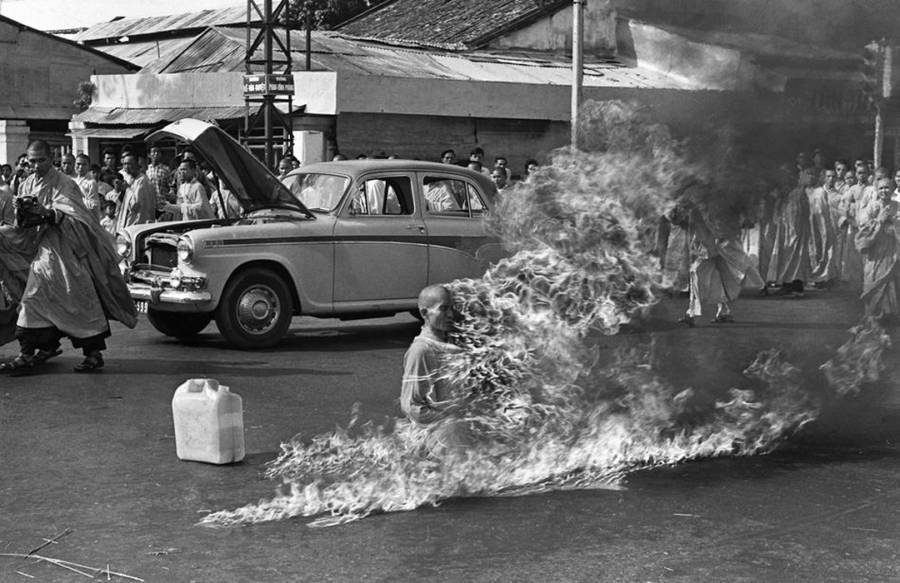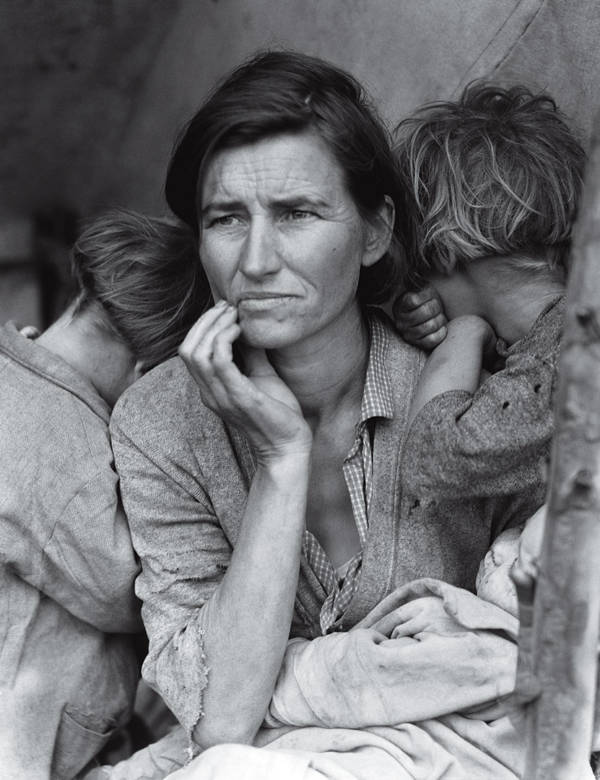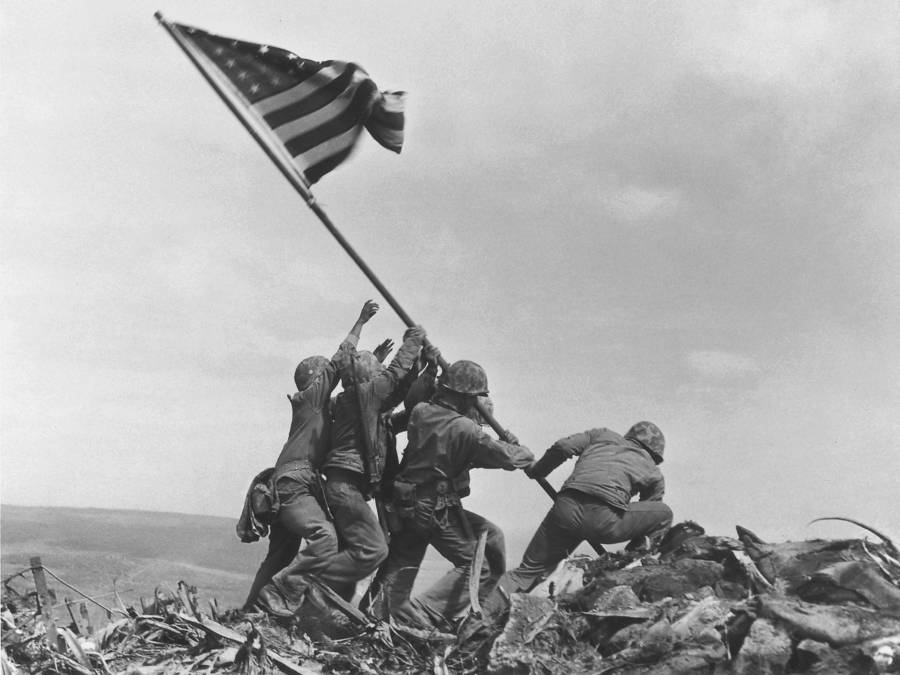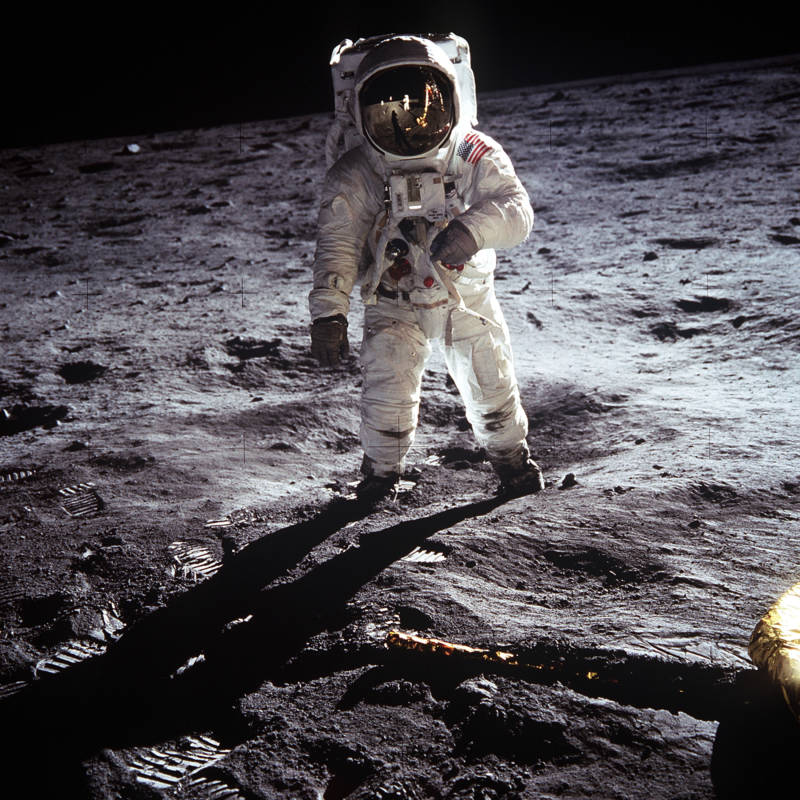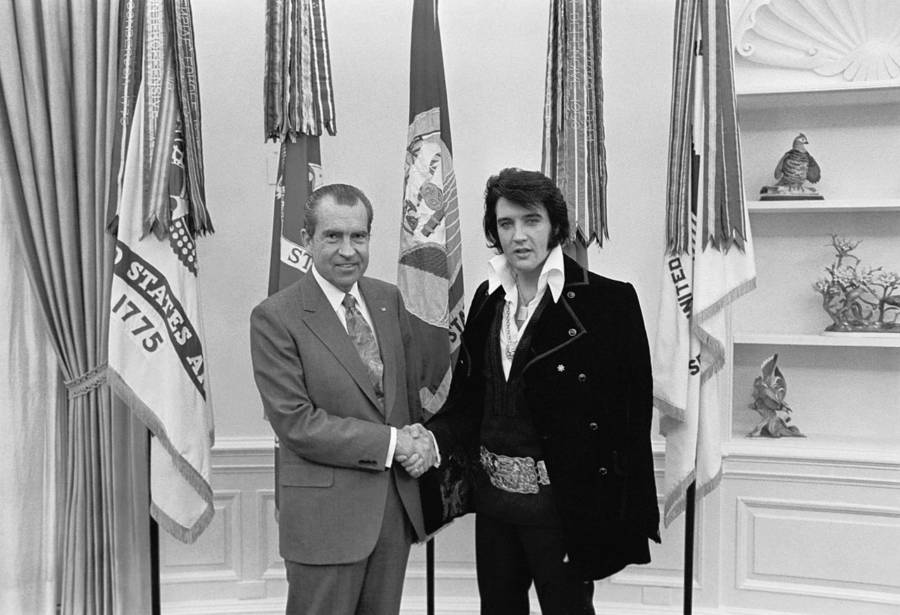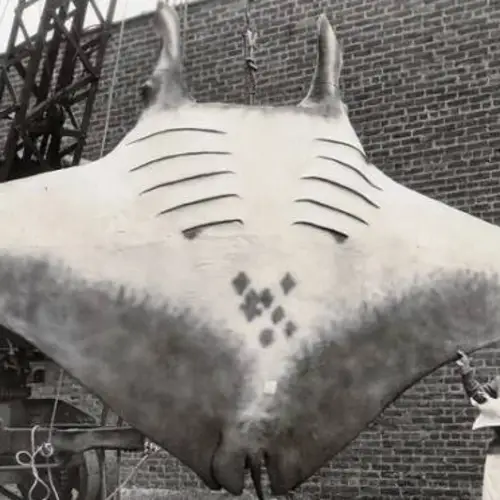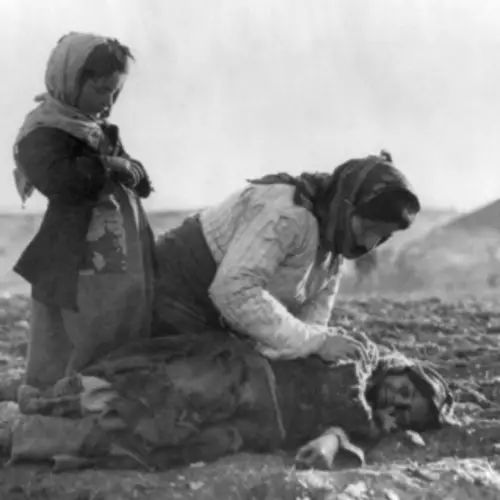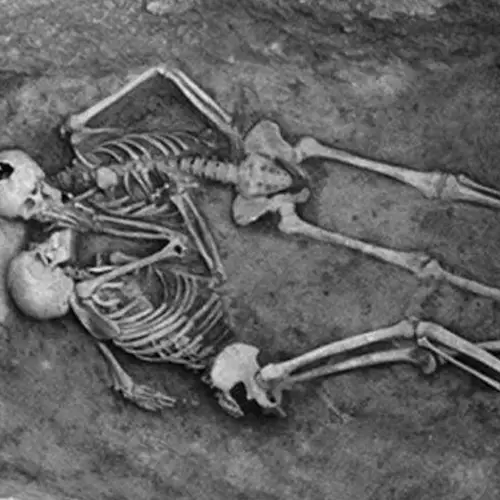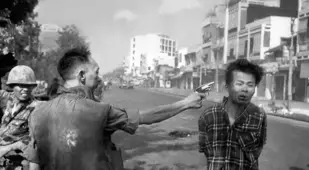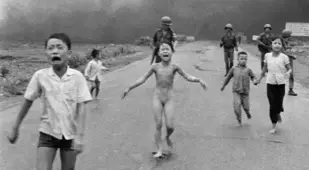1 of 25
This photo depicting the execution of Viet Cong soldier Nguyễn Văn Lém by South Vietnamese officer Nguyễn Ngọc Loan in Saigon on Feb. 1, 1968 became a symbol of the Vietnam War's senseless brutality and helped turn American sentiment against the war. However, while the photo does indeed depict a sudden, violent, summary execution, few realize that Lém was no innocent civilian or even a prisoner of war, but instead a guerrilla terrorist who had just been caught murdering the wife, children, and 80-year-old mother of a South Vietnamese officer, a friend
of Loan's, by slicing their throats.Eddie Adams/Associated Press/Library of Congress
2 of 25
Although millions have seen Kevin Carter's 1993 photo of this starving child in famine-plagued Sudan, far fewer know that the child actually lived while Carter himself, who was criticized for not intervening, did not — he killed himself a year later, explaining in his suicide note that he was destroyed by guilt and pain over taking photos just like this one. Kevin Carter/Wikimedia 3 of 25
Thanks to persistent propaganda, many, including NPR, believe this photo of nine-year-old Phan Thi Kim Phuc fleeing while suffering from napalm burns near Trang Bang, Vietnam on June 8, 1972 to epitomize the brutality of U.S. involvement in the Vietnam War. However, in reality, this strike was a South Vietnamese operation with no U.S. involvement, and was actually a mistake by a plane not intended to drop its load on the village in question. However, on the brighter side, because photographer Nick Ut helped get Phuc to an American hospital, he was able to save her life.Nick Ut/Associated Press/Library of Congress 4 of 25
Although this image of Vietnamese Buddhist monk Thích Quảng Đức setting himself ablaze in protest in Saigon on June 11, 1963 is known to millions around the world, what's surprising is how few of those people (at least in the West) likely realize what exactly Đức was protesting. While the self-immolation has become linked wholly with the Vietnam War in the West, the act was actually a demonstration against South Vietnamese President Ngo Dinh Diem's violent persecution of Buddhists, exemplified by a massacre of nine Buddhist protesters the month before the immolation.Malcolm Browne/Library of Congress
5 of 25
Little-known tidbits about this 1932 photo of California "migrant mother" Florence Owens include the fact that she was just 32 years old when it was taken, her identity remained unknown for decades, and she was falsely promised by the photographer that the image wouldn't be distributed. On the bright side, the widespread distribution of the photo convinced the government to send 20,000 pounds of food to the migrant camp in question.Dorothea Lange/Library of Congress
6 of 25
This photo does indeed depict U.S. servicemen raising the American flag atop Mount Suribachi after capturing it during the Battle of Iwo Jima on Feb. 23, 1945. However, that version of events obscures the fact that this was not the first, but actually the second, flag raising atop that hill that day, in addition to the fact that this flag raising did not mark the end of this historic battle, which actually carried on for another month and claimed the lives of three of the men in the photo over the next few days.Joe Rosenthal/Associated Press/National Archives
7 of 25
The image of Marilyn Monroe posing while filming The Seven Year Itch with her dress billowing upward thanks to the air from a New York subway grate remains among the most iconic in movie history. What not many people know, however, is that the scene was shot on actual New York streets, as this photo depicts, but the footage was ultimately deemed unusable and reshot on a stage in Los Angeles, meaning that this image isn't actually from the filming that ended up in the movie. Other little-known tidbits include the fact that the filming of this risqué scene in front of onlookers started a fight between Monroe and husband Joe DiMaggio that led to their divorce filing just weeks later, and that the dress Monroe is wearing here sold at auction for $4.6 million in 2011.Matty Zimmerman/Corpus Christi Caller-Times/Associated Press/Wikimedia Commons
8 of 25
While it has since become one of the most recognizable photos in history, this image of Argentine Marxist revolutionary Che Guevara in Havana, Cuba on March 5, 1960 was originally an afterthought, just one of two photos that photographer Alberto Korda happened to shoot of Guevara during a funeral at which Fidel Castro's speech was the actual focal point. The photo was forgotten and went unpublished for seven years until Italian publisher Giangiacomo Feltrinelli, a sympathizer of Guevara's cause, used the photo in a collection of the revolutionary's diary writings.Alberto Korda/Wikimedia Commons
9 of 25
It's not surprising that this infamous 1934 photo purported to depict the Loch Ness Monster is a confirmed hoax; what is surprising is exactly who the target of that hoax was. The perpetrator was U.K. hunter Marmaduke Wetherell, who'd been hired to track down the monster by London's Daily Mail the year before. When the paper tarnished Wetherell's reputation by discrediting the photographic evidence of the creature that he'd faked, he decided to get revenge on the Mail with the image pictured here, created with a toy submarine. And it largely worked, as the paper ran with the photo and many people believed it to be authentic for decades. Hulton Archive/Getty Images
10 of 25
This photo of AIDS patient David Kirby dying while surrounded by his family in an Ohio hospice in early 1990 changed the entire discourse surrounding the controversial disease by humanizing this victim whose final moments have since been seen by more than 1 billion people. But while this image shows Kirby's parents comforting their son, they had also rejected him upon learning of his homosexuality several years earlier, causing him to flee to California, where he contracted the disease. Therese Frare
11 of 25
On Sept. 4, 1957 in Little Rock, Ark., Elizabeth Eckford endured the screams of Hazel Bryan as the former attempted to become one of the first black students to integrate an all-white American school. The photo became a symbol of the struggle for civil rights while Bryan's face became an unparalleled symbol of hate. That said, it's worth noting that Bryan later completely reversed her youthful stance and got into social work involving young black people in Little Rock. She and Eckford even became friends in the 1990s, finding joint hobbies and enrolling in a seminar on race relations together — before ultimately falling out several years later after Eckford came to believe that Bryan hadn't taken full responsibility for the incident that came to define both women's lives.Will Counts/Bettmann/Getty Images
12 of 25
Likely the most well-known image of history's first moon landing, on July 20, 1969, this photo does not actually depict the first human to set foot on the lunar surface, Neil Armstrong, but instead shows the second, Buzz Aldrin (with Armstrong visible in the reflection on Aldrin's visor). In fact, because Armstrong was the one working the camera, virtually all of the extant Apollo 11 moon landing images feature Aldrin and not Armstrong.Neil Armstrong/NASA/Wikimedia Commons
13 of 25
What's surprising about this 1932 image, one of history's most well-known photos, is that both the subjects and even the photographer remain unknown. Furthermore, relatively few seem to realize that the building in question is New York's 30 Rockefeller Plaza, not the Empire State Building, and that the photo was staged as part of a publicity stunt.Bettmann/Getty Images
14 of 25
Most Americans likely know that Lyndon B. Johnson took the presidential oath very soon after his predecessor, John F. Kennedy, was assassinated in Dallas on Nov. 22, 1963. But it's not quite common knowledge that the oath, captured in this iconic photo, took place aboard Air Force One just two hours and eight minutes after the killing and that former first lady Jacqueline Kennedy was in attendance while still wearing the blood-spattered suit she'd had on when sitting next to her husband as he was shot and refused to take off afterward, saying, "I want them to see what they have done."Cecil Stoughton/National Archives
15 of 25
What's surprising about this 1948 photo featuring legendary Spanish surrealist Salvador Dalí is that it was created without the kind of trickery you might suspect in a case like this. You're actually seeing the perfectly-timed synchronization of Dalí jumping into the air amid furniture suspended by wires as well as cats and water tossed into the frame by assistants on the periphery. It took them 28 tries to get it right. Philippe Halsman/Library of Congress
16 of 25
On May 4, 1970, Ohio National Guardsmen killed four unarmed students and wounded nine during an anti-Vietnam War protest at Ohio's Kent State University. The defining image of the incident, and perhaps the anti-war movement as a whole, depicted Mary Ann Vecchio leaning over the body of fatally-wounded student Jeffrey Miller. What relatively few people know about this image is that Vecchio was not a student herself, but instead a 14-year-old runaway who was visiting the campus, and that the photo has become a subject of controversy due to the fact that it has run many times in major magazines in a retouched version with the post above Vecchio's head removed.John Paul Filo/Library of Congress
17 of 25
Contrary to popular belief, this Feb. 1956 booking photo of civil rights activist Rosa Parks was not taken following her famous act of resistance when she refused to give up her seat in the whites-only section of a Montgomery, Ala. bus to a white passenger. That incident occurred on Dec. 1, 1955, while this photo was taken after her subsequent arrest for bus boycott activity several months later. Universal History Archive/UIG via Getty Images
18 of 25
Another iconic historical photo whose subjects have remained uncertain even decades later, this image has seen several people claim to be those depicted, with none of them able to prove it conclusively. Furthermore, few people likely realize that, amid the enormous crowds and chaos during the V-J Day celebrations in New York's Times Square on Aug. 14, 1945, another photographer happened to capture another angle of the exact same split-second kiss — although that photo never achieved the same immortal status. Alfred Eisenstaedt/LIFE Magazine/Wikimedia 19 of 25
While the experts continue to disagree, many contend that this photo of a Republican soldier being shot to death during the Spanish Civil War on Sept. 5, 1936 was actually staged. Evidence includes a witness who claims that the photographer told him that the photo was faked, as well as analysis of the landscape suggesting that the photo couldn't have been taken where it supposedly had been.Robert Capa/Magnum Photos/Wikimedia
20 of 25
Known as the "leap into freedom," this photo of East German border guard Hans Conrad Schumann jumping the nascent Berlin Wall and fleeing into Western territory on Aug. 15, 1961 became, for many, a joyous symbol of resistance to oppression. However, what few know, as TIME wrote, is that Schumann "could not grapple with his unintended stature as a symbol of freedom, and he committed suicide in 1998."Peter Leibing/Library of Congress 21 of 25
Another iconic historical image that relatively few people realize was both staged (in direct response to the Iwo Jima flag raising photo) and retouched, this photo of Soviet troops victoriously raising their flag over the German Reichstag in Berlin on May 2, 1945 (two days after the Reichstag was actually captured) underwent one surprising edit: The lower soldier's arms were obscured so that viewers couldn't see that he was wearing two wristwatches, which would have suggested that he had been looting — unacceptable behavior for soldiers, Soviet censors thought. Yevgeny Khaldei/Library of Congress
22 of 25
Taken in Dec. 1941, with Britain weary yet resolute after more than a year at war as virtually the sole force keeping Nazi Germany at bay, this portrait of Prime Minister Winston Churchill has come to epitomize British stiff-upper-lip defiance. However, Churchill's facial expression in this photo was actually due to the fact that the photographer had literally plucked Churchill's beloved cigar from his mouth (after Churchill refused to put it down himself) just before the photo was taken.Yousuf Karsh/Wikimedia Commons
23 of 25
Perhaps the definitive image of Italian fascist dictator Benito Mussolini, this 1942 photo was in fact altered to have the horse's handler, who was holding the reins at the time, removed so that Mussolini would look more triumphant. Wikimedia
24 of 25
What's already a surprising incident at face value becomes all the more unbelievable when you learn the seldom-heard story behind the photo of Elvis Presley meeting President Richard Nixon at the White House on December 21, 1970. Presley was there to ask for a badge from the Bureau of Narcotics and Dangerous Drugs, which he believed would allow him to carry drugs and guns with him wherever he traveled. That of course wasn't the case, and the badge that Presley was given was, whether he knew it or not, purely ceremonial.Ollie Atkins/National Archives
25 of 25
Like this gallery?
Share it:



